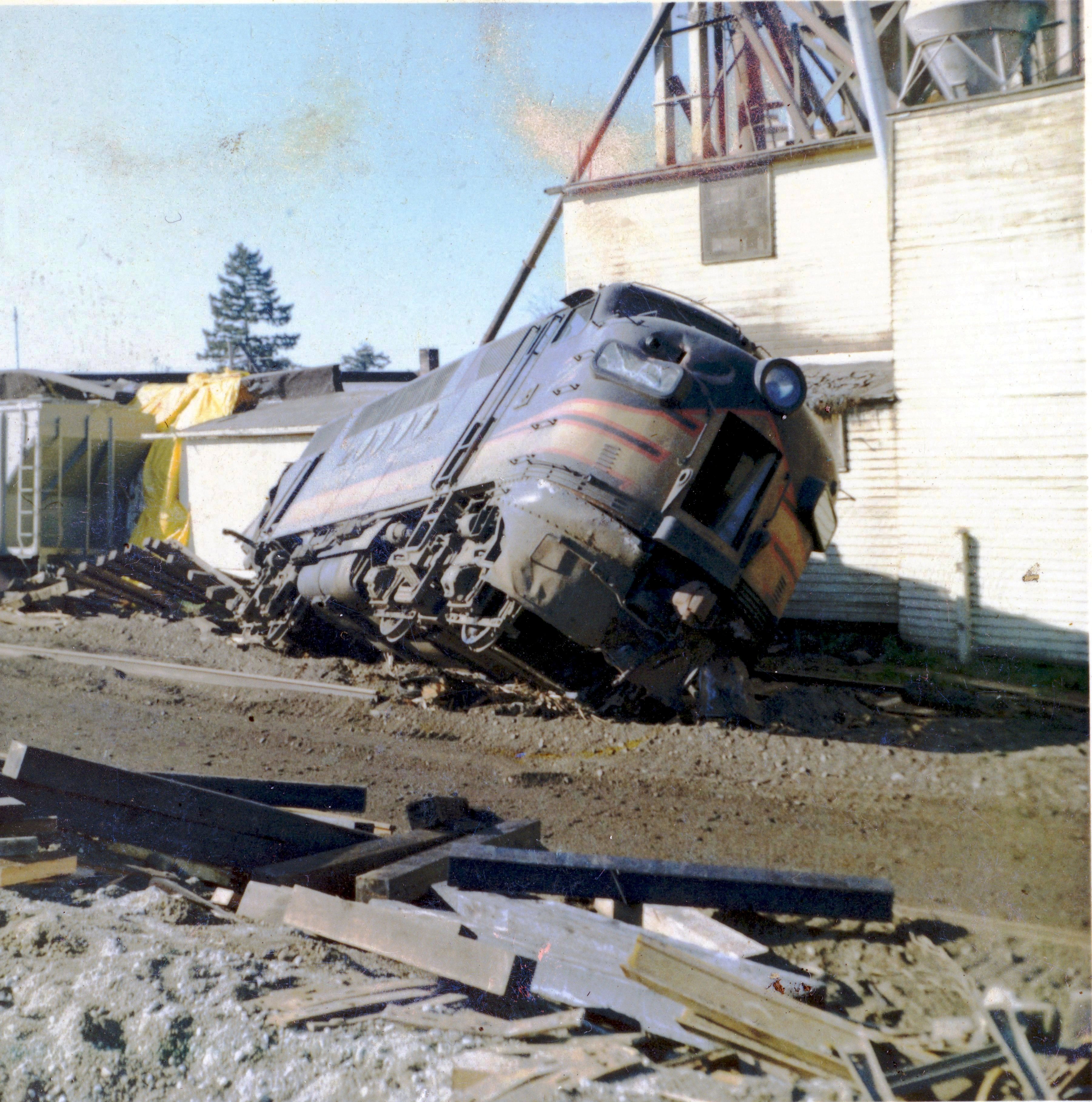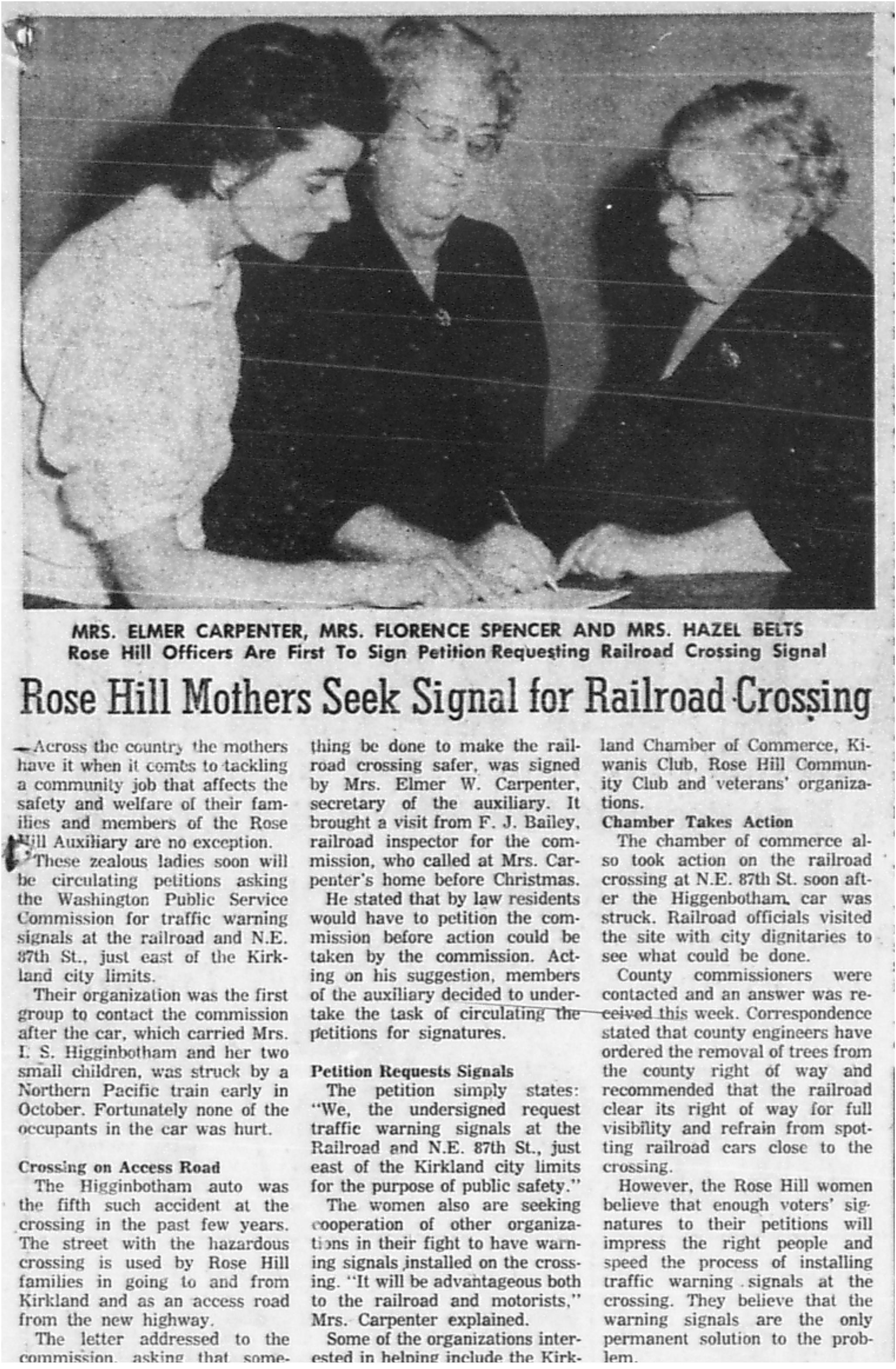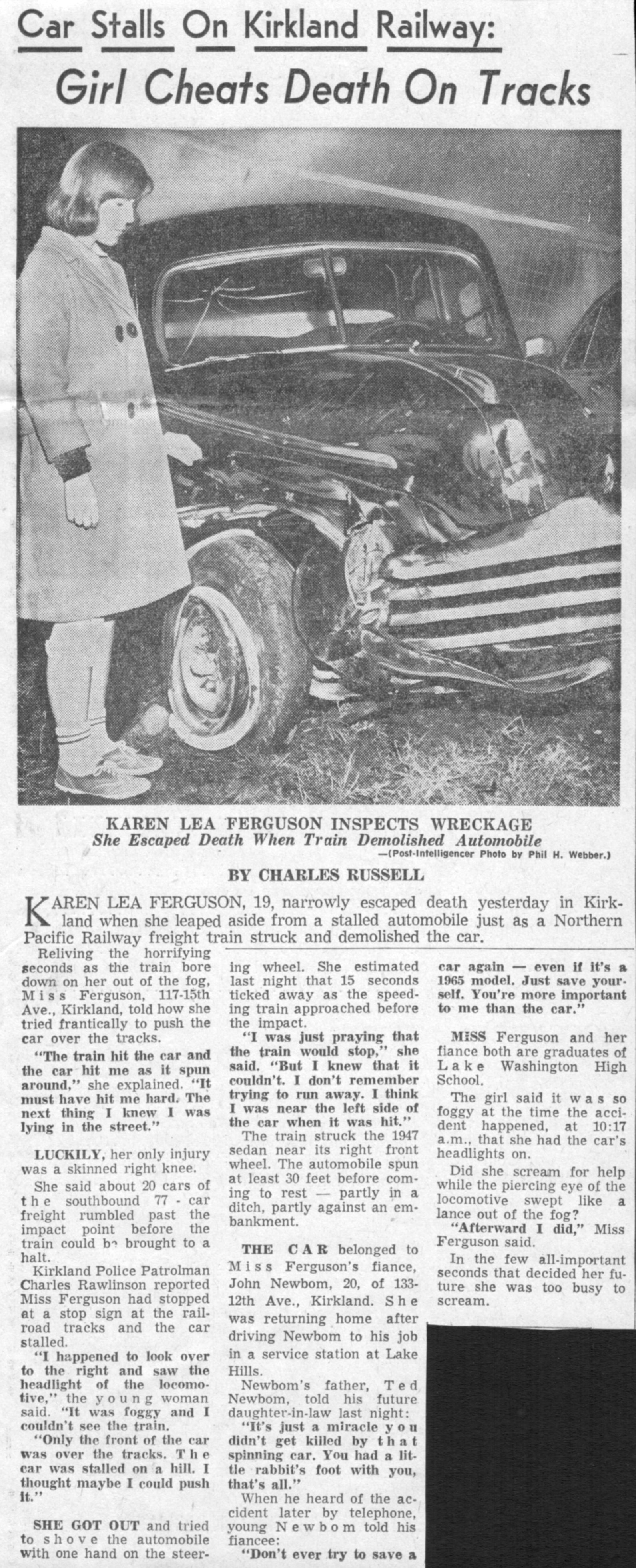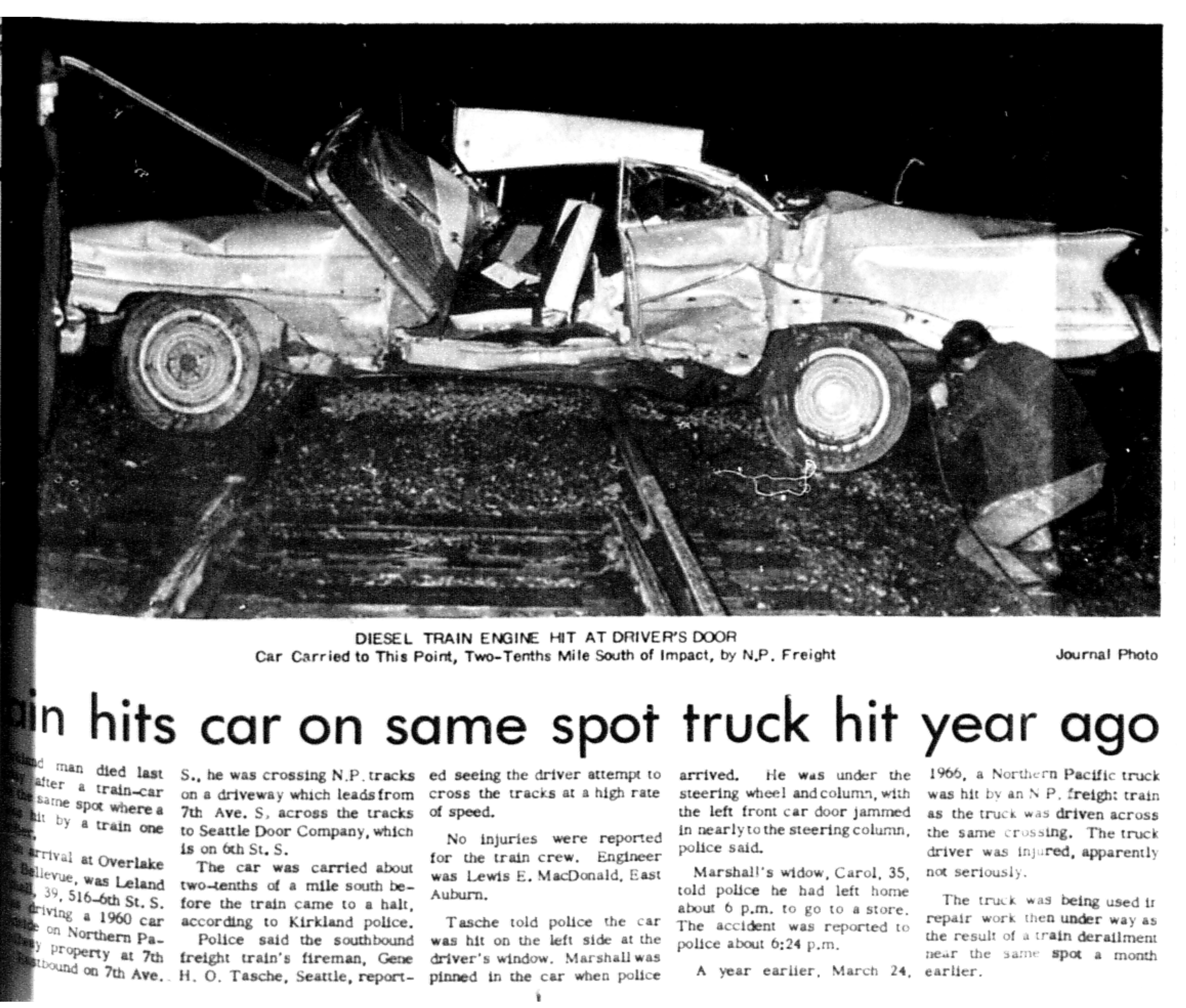By Kent Sullivan and Matt McCauley
Like any stretch of Class 1 railroad in the U. S., the LWBL had its fair share of mishaps over its 100+ year existence. Fortunately, the amount of significant property damage and loss of life was fairly small. This section describes the accidents and resulting changes that are currently known, through materials provided by community members, railfans, and newspaper clippings. It is likely that not all of the various incidents are accounted for with the materials currently on-hand.
Derailments
Research to-date has uncovered very few articles about derailments of trains or even just single freight cars in Kirkland. It’s possible that the latter type of mishap was not usually considered newsworthy. One such derailment that made the newspaper occurred in December, 1967 at Globe Feed Mills, when employee Jim Crimmen was moving a string of four loaded grain cars and they pushed an empty grain car off the end of the spur.
Perhaps the staff of the East Side Journal was primed to pay attention to railroad happenings at Globe Feed Mills due to a spectacular derailment that occurred there about 18 months earlier, on February, 20, 1966. Train 676 from Sumas was passing through Kirkland on its way to Auburn about 11pm. Because it was a Sunday, the train was fairly small (24 cars) but had the usual complement of six diesel locomotives – an A-B EMD FT set in the lead, then two EMD GP9s, then another EMD set, in B-A order.

Somehow, the switch at the north end of the Seattle Door Co. siding was lined for the siding instead of the main track. Train 676 lumbered onto it and ran into an automatic derailing device, which caused all six locomotive to tumble off the tracks, but with enough momentum knock a box car off the tracks at Virginia Lee Homes warehouse, shove a grain car on the Globe Feed Mills siding into the mill’s warehouse, and plant the rear-most locomotive partially in the warehouse as well. Amazingly, besides the locomotives, only the first two cars of the train derailed. Fortunately, the six crewmen on the train – three in the lead locomotive and three in the caboose, were unhurt. An estimated $85,000 damage was done to the train and track, with an unknown amount to Globe Feed Mills. Several Kirkland youths were questioned by NP special agents, the FBI, and local police, although normally, the switch should have been locked and not movable except by a railroad employee. A temporary “shoo fly” track around the derailment was installed on Monday and operation was restored to the main track on Saturday. The Seattle Times also covered the wreck with a front-page photo.
.jpg)
Collisions between trains and automobiles and resulting safety improvements
The NP documented wrecks of all kinds but none of those records have been found to date. Based solely on what was reported in the East Side Journal, there are scant stories of collisions between trains and automobiles for the first many years. The first two known incidents occurred a little more than 10 years apart, February, 1919 and July, 1929, at the same location – the Piccadilly Street (7th Avenue) crossing. In both cases, the automobiles were destroyed and people were thrown from the vehicles but, miraculously, no one was killed.
No articles have yet been found describing collisions in the 1930s or 1940s. By Spring, 1951, however, at least one crossing was proving to be a problem – NE 52nd Street. From the brief description in the article, it appears the approach on the west side was too steep to allow for good visibility and possibly adequate stopping distance. The town planned to flatten out the approach and move it slightly north, as well as to ask the NP to install a flashing signal – the first such request found to date. However, these improvements were still being discussed in August, 1956 and it is not known if or when they were eventually enacted.
Population in Kirkland continued to grow quickly following World War II, and with it came more cars on the road and more opportunities for grade crossing collisions. In June, 1952 the city requested flashing signals at what were likely the two busiest grade crossings – 7th Avenue in the Piccadilly area and 6th Street S in Feriton, as well as continued efforts for some sort of safety devices in the Five Corners area (today’s NE 124th Street and Totem Lake Boulevard). The latter effort may have been prompted by a near-miss collision a couple of months prior and concern expressed by the Five Points Community Club.
Discussion apparently continued on the 7th Avenue crossing for quite some time. In November, 1958, the Kirkland Chamber of Commerce came out in favor of warning signals. A multi-party task force visited the site in December, resulting in the NP agreeing to have its engineering department study the situation. In late January, 1959, a group of mothers, representing families living on Rose Hill, prepared a petition to press the NP to install traffic warning signals at that crossing. The article noted that there had been five collisions there in the past few years. In the meantime, King County engineers ordered removal of trees near the crossing that might be limiting visibility. The Ladies Auxiliary of the Rose Hill Club circulated the petitions in February and March.
In early April, another collision occurred there, on the same day that the petition, with approximately 400 signatures, was sent to the Washington State Public Service Commission. (Note: That article gives the location as NE 85th Street instead of NE 87th Street, which is incorrect.) The petition was somewhat successful: King County installed upgraded warning signs at this intersection in June, 1959 as a “temporary measure” and, as part of that measure, the NP agreed to repaint and reflectorize its signs. Similar work was done at the NE 112th Street crossing (in the area that would become Par-Mac), which had also become a source of collisions. In March, 1961, the City installed stop signs at the 7th Avenue location. Stop signs were also installed at the NE 112th Street crossing at some point.
In the early 1960s, two more serious collisions happened in the Five Points area, one year apart, in April, 1962 and April, 1963. No one was seriously injured in either of these mishaps. The authors suspect that enough other collisions occurred in this area to spur the NP to authorize installing two sets of flashing light signals, at Slater Avenue NE in October, 1964 and NE 124th Street in August, 1965.
Meanwhile, two different collisions happened at an unofficial crossing of 7th Avenue S in Feriton, on the Seattle Door property, in July, 1962 and June, 1963. In the first case, a car was parked too close to the tracks. However, luck ran out at this location in March, 1967 when a local man was killed at the same crossing, perhaps the first crossing fatality in Kirkland. The authors assume that this unofficial crossing was discouraged and eventually closed.
The NP and the City finally took action at the 6th Street S intersection in Feriton in 1969. The City contracted with the NP in May, 1969 to install warning signals as part of a larger improvement project for that street, which was completed in July, 1970.
Discussions about safety measures beyond stop signs at the NE 112th Street crossing in the Par-Mac area continued. The Five Points Community Club presented a petition before the City Council in June, 1969. No action was taken, however, and the issue was brought up again in October, 1972 and debated in August, 1973. The Community Club may have had more success at 124th Ave. NE (Totem Lake Blvd.), however, because the Burlington Northern authorized flashing grade crossing signals on June 29, 1971. On October 10, 1977, the BN authorized the replacement of those signals with an overhead cantilever design, likely due to the street being widened, with work to be completed by May, 1978.



